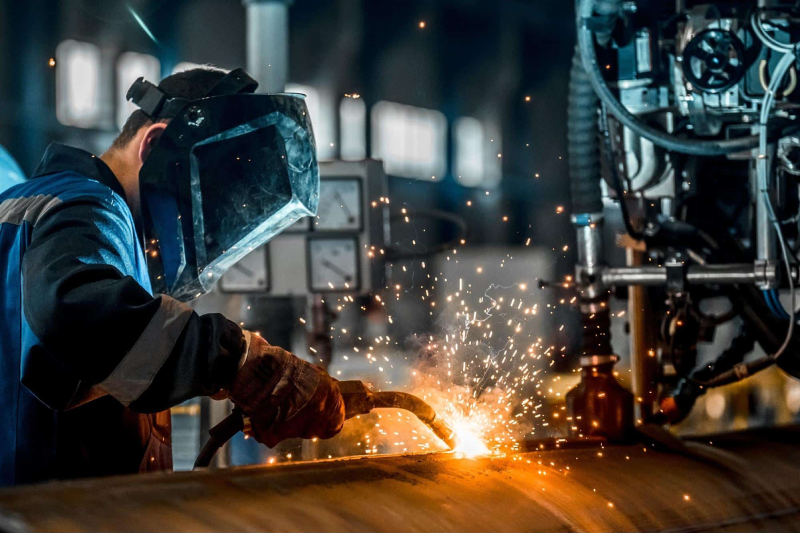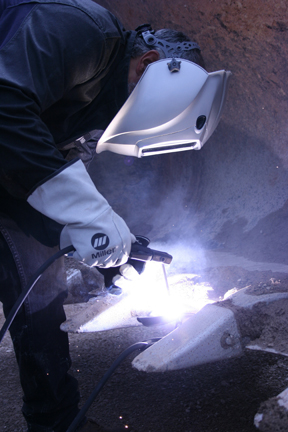Typical Welding Fixing Issues and Exactly How to Address Them Successfully
Welding repairs typically run into a range of concerns that can jeopardize the stability of the last item. Common issues include insufficient infiltration, porosity, and misalignment, among others. Each flaw offers special challenges that require certain strategies for resolution. Comprehending these concerns is necessary for welders aiming to improve their skills and end results. This discussion will certainly check out these typical welding repair problems and reliable methods to address them.
Inadequate Infiltration
Insufficient penetration takes place when the weld steel falls short to totally fuse with the base product, leading to weak joints and possible architectural failings. This issue frequently comes from insufficient heat input, wrong electrode angle, or inappropriate welding speed. Welders might run into poor infiltration as a result of a miscalculation of the needed criteria for a details material thickness or type. In addition, contamination on the base product's surface can hinder reliable bonding, aggravating the problem. To address inadequate penetration, welders must assure suitable settings on their equipment and maintain a tidy work surface area. Routine examination of welds is advised to determine any type of deficiencies early, permitting timely improvements and the prevention of endangered architectural honesty in bonded settings up.
Porosity
Porosity is a typical flaw in welded joints that manifests as tiny gas bubbles caught within the weld steel. This issue can jeopardize the integrity of the weld, leading to decreased stamina and possible failure under stress and anxiety. Montana Mobile Welding and Repair Belgrade. Porosity commonly arises from contamination, moisture, or inappropriate welding methods, which enable gases to leave into the liquified weld pool. To attend to porosity, welders must assure proper surface area preparation, maintain a tidy workplace, and utilize suitable welding specifications. In addition, picking the ideal filler product and protecting gas can mitigate gas entrapment. Normal assessment and screening of welds can assist recognize porosity early, assuring timely restorative activities are taken, therefore preserving the high quality and reliability of the welded framework
Misalignment
Imbalance in welding can develop from various aspects, including inappropriate arrangement and thermal growth. Understanding the source is essential for reliable resolution. Several adjustment methods are available to realign parts and ensure structural integrity.
Reasons for Imbalance
Welding imbalance commonly stems from a range of underlying issues that can endanger structural honesty. One key cause is improper fit-up of parts prior to welding, which can cause voids and unequal surface areas. Variations in thermal growth throughout the welding procedure can likewise lead to distortion, specifically if the products being signed up with have different coefficients of development. In addition, inadequate clamping and fixturing might fall short to hold elements firmly in position, leading to activity during welding. Inadequately maintained devices, including welding makers and tools, may introduce disparities in the weld bead, further adding to misalignment. Operator mistake, stemming from insufficient training or experience, can likewise play a significant duty in producing misaligned welds.

Improvement Strategies Available
Resolving imbalance successfully calls for a combination of restorative methods tailored to the certain concerns at hand. One common method is the usage of jigs or fixtures to hold parts in the correct setting throughout welding, making certain constant positioning. In addition, preheating the products can help reduce distortion and boost fit-up. For considerable misalignment, mechanical adjustment techniques, such as using hydraulic jacks or clamps, can be employed to deal with the setting before welding. Post-weld heat therapy might also be essential to relieve stresses caused by misalignment. Mindful assessment and adjustment throughout the setup phase can avoid misalignment concerns from becoming substantial problems, promoting a smoother welding process and improving general structural honesty.
Distortion
Distortion is a typical difficulty in welding that can occur from numerous variables, including uneven heating and air conditioning. Understanding the causes of distortion is crucial for carrying out efficient avoidance strategies. Resolving this issue not just boosts architectural honesty yet additionally enhances the total top quality of the weld.
Sources of Distortion
When based on the extreme heat of welding, products frequently undertake changes that can result in distortion. This phenomenon mainly arises from thermal development and tightening throughout the welding process. As the weld area warms up, the material increases; upon cooling, it contracts, which can develop interior stresses. Furthermore, irregular home heating throughout a workpiece can exacerbate these tensions, causing warping or flexing. The kind of product also plays a significant duty; metals with varying thermal conductivity and coefficients of development may respond in a different way, leading to unforeseeable distortions. In addition, bad joint style and poor fixturing can add to imbalance during welding, increasing the chance of distortion. Understanding these causes is essential for reliable welding repair work and prevention strategies.
Prevention Techniques
Effective avoidance strategies for distortion during welding focus on managing warmth input and making certain correct joint layout. Preserving a constant heat input helps to reduce thermal expansion and contraction, which can bring about distortion. Utilizing strategies such as preheating the workpiece can additionally lower the temperature slope, advertising consistent heating. Additionally, choosing suitable joint layouts, such as T-joints or lap joints, can enhance stability and lower stress and anxiety concentrations. Applying proper fixturing to protect the workpieces in location better help in preserving positioning throughout the welding procedure. Ultimately, staggered welding series can distribute heat much more uniformly, preventing localized distortion. By using these techniques, welders can substantially reduce the possibility of distortion and boost the general quality of their welds.
Fracturing
Fracturing is a common concern encountered in welding repairs, commonly arising from different variables such as inappropriate air conditioning rates, material choice, or poor joint prep work. The event of splits can considerably compromise the honesty of the weld, leading to possible failings during procedure. To resolve this problem, welders must initially examine the origin triggers, ensuring that products work and properly selected for the specific application. Additionally, controlling the air conditioning price throughout the welding procedure is important; rapid air conditioning can induce anxiety and result in breaking. Correct joint style and prep work additionally contribute to lessening the threat. Applying these techniques can improve weld top quality and sturdiness, inevitably lowering the possibility of splitting in finished weldments.

Incomplete Fusion
A substantial concern in welding repairs is insufficient fusion, which takes place when the weld visit their website metal does not effectively bond with the base material or previous weld passes - Montana Mobile Welding and Repair Belgrade Welding. This defect can result in weak points in the joint, potentially jeopardizing the honesty of the bonded structure. Factors adding to incomplete combination consist of not enough warm input, improper welding strategy, and contamination of the surfaces being joined. To address this issue successfully, welders ought to guarantee correct pre-weld cleansing and surface area preparation, in addition to readjust their welding criteria to accomplish sufficient penetration and combination. Normal inspection throughout the welding process can likewise aid determine insufficient combination early, permitting timely corrective steps to enhance the total high quality of the weld
Overheating
While welding repairs can improve architectural honesty, overheating offers a substantial challenge that can result in material degradation. Excessive warmth during welding can modify the mechanical residential or commercial properties of steels, leading to decreased toughness, boosted brittleness, and bending. This sensation is specifically crucial in high-stress applications where architectural dependability is paramount. Determining getting too hot can entail visual inspections for discoloration or distortion, as well as keeping an eye on temperature throughout the welding procedure. To reduce the threats connected with getting too hot, welders need to utilize ideal methods, such as regulating warmth input, readjusting traveling speed, and using ideal filler products. In addition, carrying out pre- and post-weld warm therapies can assist restore material buildings and improve the overall quality of the repair service, making sure long-lasting efficiency and safety.
Regularly Asked Inquiries
What Are the Common Indications of a Welding Defect?

Just How Can I Evaluate My Welds for Quality?
To examine welds for quality, one can utilize aesthetic evaluations, ultrasonic testing, and radiographic approaches. Each technique ensures architectural integrity, identifies problems, and validates adherence to defined criteria, eventually enhancing the dependability of the welded joints.
What Safety and security Preventative Measures Should I Take While Welding?
When welding, one must prioritize security by using appropriate personal protective tools, ensuring proper ventilation, securing flammable products away, keeping a tidy office, and being mindful of surroundings to avoid injuries and mishaps.
Can I Repair a Weld Without Redoing the Entire Joint?
Fixing a weld without redoing the entire joint is possible, depending on the damages (Belgrade their website Welding). Methods such as grinding, adding filler material, or making use of a welding process can effectively deal with certain problems while maintaining the surrounding structure
What Tools Are Essential for Reliable Welding Repair Works?
Crucial tools for reliable welding fixings consist of a welding maker, wire brush, grinder, safety equipment, clamps, and filler materials. Each device plays a vital duty in making certain high quality and security during the repair process. Porosity typically occurs from contamination, dampness, or incorrect welding techniques, which permit gases to leave into the liquified weld pool. Poorly maintained devices, consisting of welding equipments and tools, may introduce disparities in the weld grain, more adding to imbalance. visit this web-site When subjected to the extreme heat of welding, materials often undertake changes that can lead to distortion. Cracking is a typical problem come across in welding fixings, often resulting from various factors such as inappropriate cooling rates, product selection, or poor joint preparation. A substantial issue in welding fixings is insufficient fusion, which occurs when the weld steel does not sufficiently bond with the base product or previous weld passes.